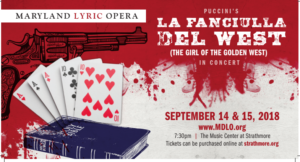
How ‘La Fanciulla Del West’ Came To Maryland Lyric Opera’s Rescue
By Greg WaxbergJust like its heroine does in the final act, Puccini’s magnificent western “La Fanciulla del West” has come to the rescue.
Because Maryland Lyric Opera’s original season-opening plans did not come to fruition, due to schedule challenges and a change in venue, it is now possible for Maryland-area audiences to become acquainted—or better acquainted—with this often-overlooked Puccini gem.
Entering its fifth year and fulfilling a mission to support young artists, particularly graduates of its Young Artist Institute, the company will present two concert performances (with two sets of lead singers) of “Fanciulla” on September 14 and 15 in the Music Center at Strathmore.
In that large hall with 1,800 seats, the soloists, chorus, and 75-member Maryland Lyric Opera Orchestra (consisting of many freelance musicians) will take the stage for a purely musical rendition—well, “purely musical” except for the necessary addition of gun shots!
Even with the change of plans, “Some of the folks we wanted to do these roles happened to be available on those dates,” says Maryland Lyric Opera General Manager Matthew Woorman.
Coming to the Rescue
How did “Fanciulla” enter the picture? With the company committing to perform in the acoustically rich Music Center and seeking to highlight the orchestra’s capabilities, Music Director Louis Salemno knew they needed “a big opera.” Envisioning the possibilities, he was having a tough time with the decision until Woorman suggested “Fanciulla.”
Salemno was intrigued and sent an email with six words to English soprano Susan Bullock, whose credits include Minnie, Elektra, Salome, Isolde, and Brünnhilde, and whom Salemno conducted as Tosca in Portland, Oregon in 1998.
Those six words: “How do you feel about Minnie?”
Within one hour, the response: “I love Minnie!” And she was available when the company would need her, to headline the first cast on September 14. “We did not want to do ‘Fanciulla del West’ without the finest singer I knew of who could come,” Salemno says. “She is a phenomenal soprano. I’m from the ‘old school’—if I can’t find the singers, I don’t do the opera. I don’t pick the opera and then try to find the singers.”
A Masterpiece
Salemno is a huge fan of “Fanciulla,” an opera whose plot involves basic, relatable human actions and emotions: falling in love, being enamored with someone, making a mistake in life, taking risks for a loved one, and homesickness, among them. He became acquainted with the opera 40 years ago, in September 1978, as a rehearsal pianist under Bruno Bartoletti’s direction at Lyric Opera of Chicago.
“It’s a phenomenal piece of theater. I’m crazy about it,” he declares. “Puccini finds the humanity in whatever topic he presents. When it comes to writing about the love between a man and a woman, Puccini is a master—Rodolfo/Mimì, Marcello/Musetta, Pinkerton/Butterfly, Cavaradossi/Tosca, Dick Johnson/Minnie.”
Although some people cite the opera’s vocal challenges and lack of recognizable arias for the dearth of performances, Salemno points out the huge cast that makes it an expensive opera to produce. “There are 18 roles. When producers look at the costs, they think twice, because if they can find three protagonists to sing ‘Fanciulla del West,’ those three singers can sing ‘Tosca.’ Given budgetary restraints, they usually opt for ‘Tosca,’ which sells out.”
These observations lend themselves to a “chicken versus egg” scenario: Is “Fanciulla” not well-known because it is seldom produced, or is it seldom produced because it is not well known? And did the large cast set the opera up to endure a tough life?
Whatever the answers might be, performances are special. Excited to bring “Fanciulla” to Maryland Lyric Opera’s audiences, Woorman says, “Just like opera itself, if you don’t have any exposure to this piece, you can’t love it.”
Categories
Special Features

